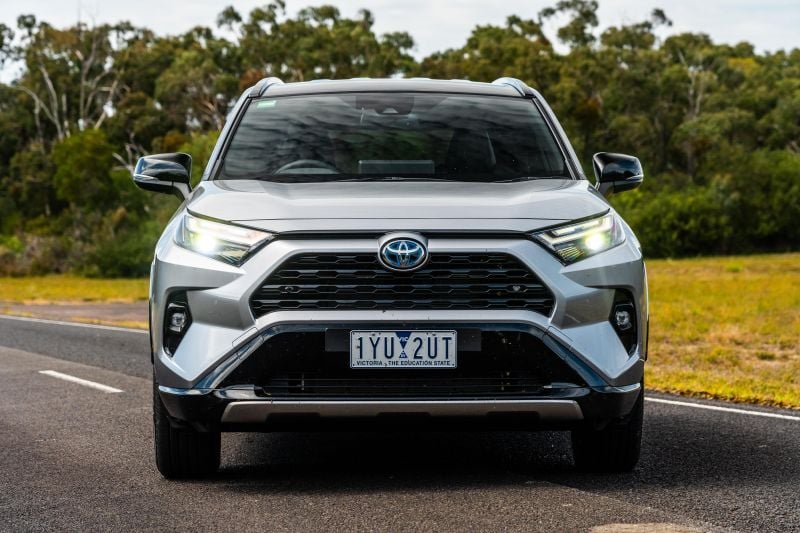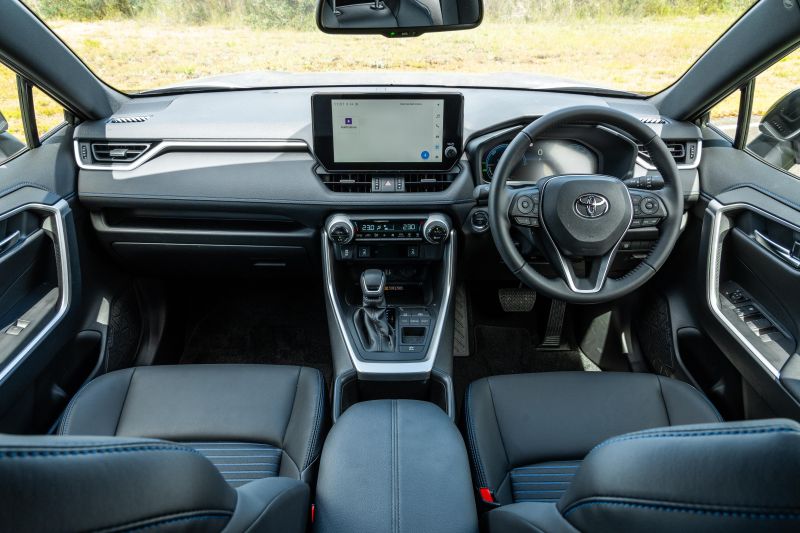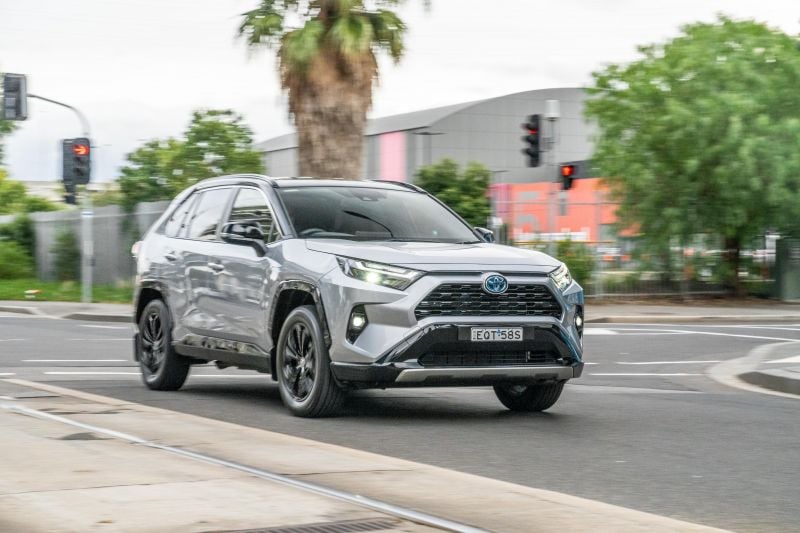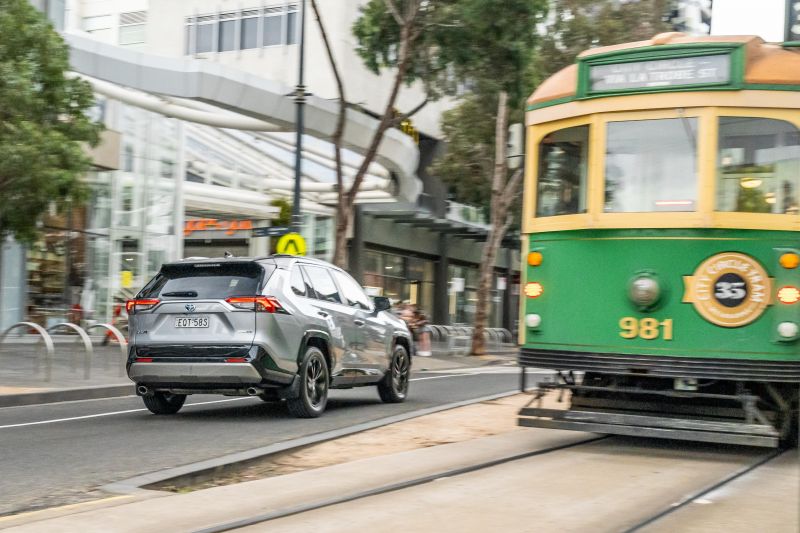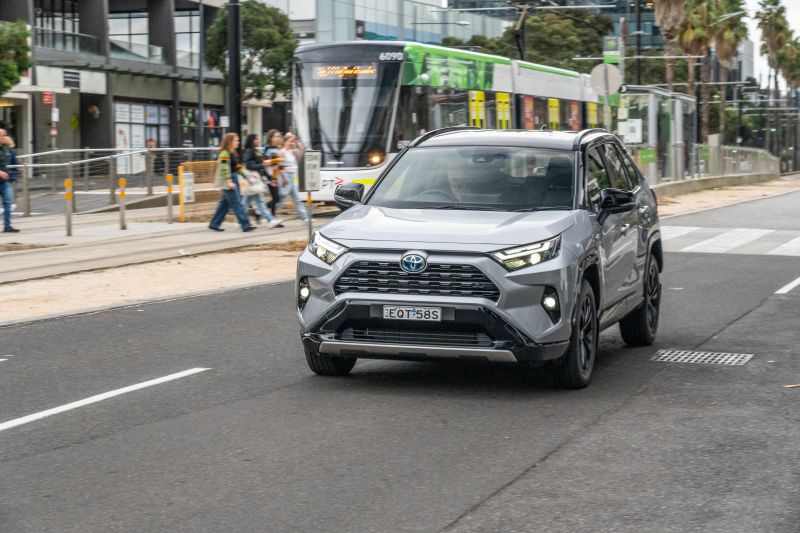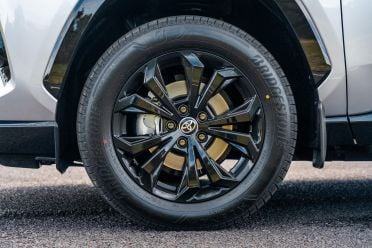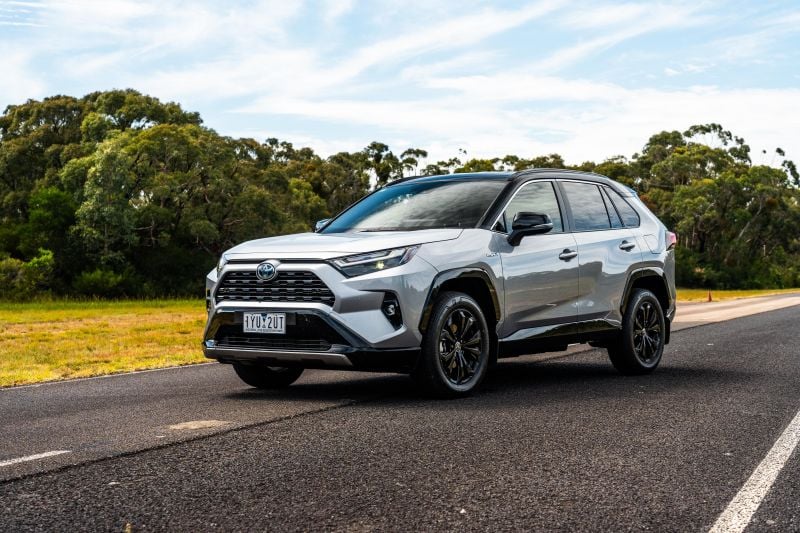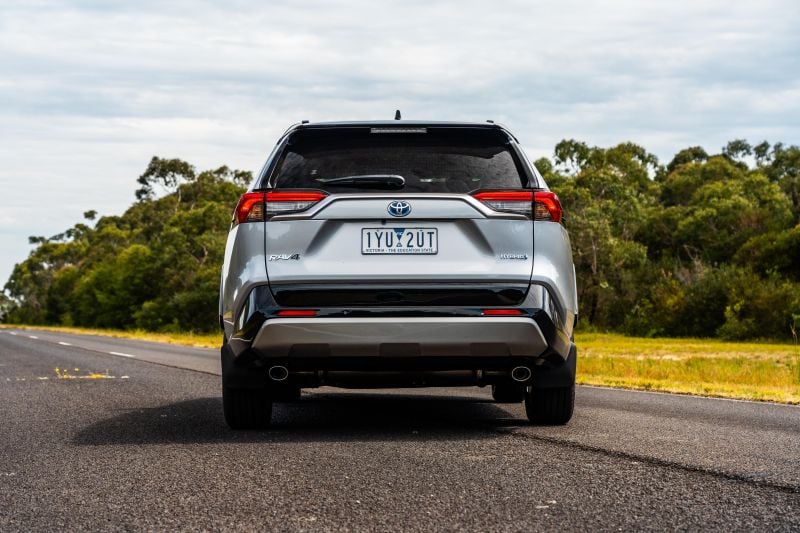The Toyota RAV4 Hybrid is still hot property, but it’s becoming easier to get in Australia.
Wait times for the electrified SUV hit between 18 and 24 months during the COVID pandemic, and are currently sitting at around 12 months – but come the middle of 2024, the brand expects that figure to be closer to six months.
Provided it can make good on its promise, the influx of supply means it might finally be time for the mid-sized SUV shopper to have a close look at the RAV4 again.
Hybrid power is offered across the RAV4 line-up, but the RAV4 XSE on test here is the only model that can’t be had with pure petrol power: it’s a hybrid only affair.
This variant was added to the range in 2022 to help meet outsized demand for high-end hybrid variants.
Now there’s a chance of getting one in a reasonable time the question remains – is the XSE Hybrid the RAV4 to buy?
How does the Toyota RAV4 fare vs its competitors?
View a detailed breakdown of the Toyota RAV4 against similarly sized vehicles.

Toyota
RAV4
How much does the Toyota RAV4 cost?
Toyota RAV4 pricing:
- Toyota RAV4 GX 2WD: $39,760
- Toyota RAV4 GX 2WD Hybrid: $42,260
- Toyota RAV4 GX AWD Hybrid: $45,260
- Toyota RAV4 GXL 2WD: $43,310
- Toyota RAV4 GXL 2WD Hybrid: $45,810
- Toyota RAV4 GXL AWD Hybrid: $48,810
- Toyota RAV4 XSE 2WD Hybrid: $49,585
- Toyota RAV4 XSE AWD Hybrid: $52,585
- Toyota RAV4 2WD Cruiser: $48,910
- Toyota RAV4 Cruiser 2WD Hybrid: $51,410
- Toyota RAV4 Cruiser AWD Hybrid: $54,410
- Toyota RAV4 Edge AWD: $56,230
- Toyota RAV4 Edge AWD Hybrid: $58,360
Prices are before on-road costs
The Toyota RAV4 is a best-seller in one of Australia’s most competitive new car segments. To see how it shapes up against its rivals, use our comparison tool.
What is the Toyota RAV4 like on the inside?
The RAV4 is a quality item inside, with lots of thoughtful touches that make it feel a bit special.
Along with the electric blue prevalent in this XSE model, things like the rubberised door pulls and climate controls play nicely into the rugged, soft-road promise of the exterior.
The fundamentals are excellent, too. The driver and passenger sit in generously padded seats with leather bolsters and cloth inserts, and everything you touch feels high quality.
We’ve accused the smaller Corolla Cross of being a bit bare-bones, but that’s not something you could label the bigger RAV4.
Toyota has also dramatically improved the technology, which was previously a weak spot.
The new infotainment screen is a huge step forward from what was offered previously, and makes the display in the pre-update model look tiny. It’s easy to use, with slick graphics and wireless smartphone mirroring that connects quickly and doesn’t drop out.
The digital instrument binnacle is clean and simple, with more customisation options than the oversized trip computer display that previously featured; although, it’s not a patch on what you get in the latest Volkswagen Group products.
Storage up front is good. There are two cupholders, along with a wireless phone charger beneath the dashboard that is shaped to keep your phone in place. The underarm bin is deep, and the door pockets have space for big bottles.
A single USB-A port is on hand for anyone who wants to phone mirror with a cable, and there are two USB-C ports hidden away up front for fast charging. There are two more USB-C ports in the rear.
The rear seats in the RAV4 are among the best in class, although they’re not quite as versatile as those in the Honda CR-V. The rear doors also don’t open quite as wide as the 90-degree units in the Honda, making it slightly harder to load in bulky items like a child seat.
Legroom behind taller drivers is good, and there’s plenty of headroom thanks to the upright profile. As is the case in the Honda, there are rear air vents and a fold-down central armrest back there. ISOFIX points feature on the outboard rear seats, and there’s a trio of top-tether points.
Boot space is a claimed 580 litres with the rear seats in place, and the rear bench folds 60:40 – but doesn’t slide like those in some rivals. Points to Toyota for putting a remote release for those folding seats in the boot.
What’s under the bonnet?
| Model | Toyota RAV4 2WD Hybrid |
|---|---|
| Engine | 2.5L 4-cyl petrol + 1 x electric motor |
| Power | 131kW + 88kW – 160kW combined |
| Torque | 221Nm + 202Nm |
| Transmission | e-CVT |
| Driven wheels | Front-wheel drive |
| Weight | 1690kg (kerb) |
| Fuel economy (claim) | 4.7L/100km |
| Fuel economy (observed) | 5.5L/100km |
| Fuel tank size | 55L |
| Fuel requirement | 91 RON |
How does the Toyota RAV4 drive?
The RAV4 will feel instantly familiar to anyone who’s driven a Toyota hybrid.
It starts up in electric mode and generally leans on the e-motor between standstill and around 20km/h, at which point the petrol engine kicks in to keep you rolling. The handover between electric and petrol power is smooth, but it’s still noticeable when the petrol engine does kick in.
Really put your foot down and there’s a surprising amount of punch, as the two power sources combine to deliver more performance than the petrol engine can on its own.
That means it feels more confident accelerating uphill with family on board, or overtaking at highway speeds. Although it’s not as powerful as the all-wheel drive model, this front-drive XSE doesn’t feel any slower in the real world.
Part of the RAV4’s enduring appeal is how easy it is to live with in the city. Its steering is light and direct, and the elevated driving position relative to a passenger car – or a smaller SUV like a Corolla Cross – makes it easy to place.
Ride quality is excellent, nicely isolating occupants from sharp bumps in the city.
It’s a relaxed cruiser at highway speeds, too. Insulation from the outside world is excellent, and the petrol engine hums away quietly in the background at a cruise. It won’t flick into EV mode as often as newer hybrids from Honda, but downhill or when you’re coasting down to a lower speed limit, the engine will turn off to save fuel.
Australia is small in the context of Toyota’s empire, but Toyota is a big player here. Its experience shows on coarse-chip highways, where the RAV4 does a great job muting road roar that would otherwise sneak into the cabin of rivals.
Toyota’s driver assists are less prone to inane beeping than before, and the adaptive cruise control does a good job maintaining a gap to the car in front.
The lane-keeping assist stays hands-off for the most part, only intervening if you stray towards the white lines, but the lane-centring system is a bit too grabby for my liking.
We’ve heaped praise on the latest TNGA-underpinned Toyota products for feeling more engaging if you actually enjoy driving, and the RAV4 remains a pretty nice SUV to hustle along.
The steering is fluid, and it doesn’t want to fall over when you tip into a corner. Neither of those are things that could’ve been said about the previous model.
What do you get?
RAV4 GX highlights:
- Parabolic LED headlights with auto-levelling
- Front LED fog lights
- Automatic high-beam
- Automatic headlights
- Rain-sensing wipers
- 17-inch alloy wheels
- Heated, power-folding exterior mirrors
- 8.0-inch touchscreen infotainment system
- Satellite navigation
- DAB+ radio
- Wireless Apple CarPlay, Wired Android Auto
- Six-speaker sound system
- 7.0-inch instrument cluster screen
- 60/40 split-fold rear seats and centre armrest
- Dual-zone climate control (hybrid only)
- Keyless start
- Leatherette-wrapped steering wheel
- Front/rear carpet mats
- Space saver spare tyre
- Electronic parking brake
- LED interior lighting
- LED daytime running lights
- Rear mudflaps
- Resin rear spoiler
- Rear passenger air vents
- 2x front and 2x rear cup holders
- 3x front and 2x rear USB ports
- 12-month subscription to Connected Services
RAV4 GXL adds:
- 18-inch alloy wheels
- ‘Premium’ grille and bumper combo
- Rear privacy glass
- Leatherette-wrapped shifter
- Auto-dimming rear-view mirror
- Dual-zone climate control
- Proximity entry
- Wireless phone charging
- Front mudflaps
- Roof rails
- Illuminated interior door switches
- Two-level boot floor
- Parabolic LED headlights with auto-levelling (petrol) or projector LED headlights (hybrid)
RAV4 XSE adds:
- Black exterior accents
- Black two-tone roof finish
- 18-inch alloy wheels in gloss black
- Black headliner and pillar garnish
- Leather-accented door trims
- Ambient lighting (model-specific)
- Softex ‘premium’ seat upholstery
- Heated front seats
- 10-way power adjustment with lumbar support (driver)
- 12.3-inch digital instrument cluster
- 10.5-inch infotainment display
- Power tailgate
- Navigation with Toyota Connected Services subscription
- Projector LED headlights
Is the Toyota RAV4 safe?
The Toyota RAV4 wears a five-star ANCAP safety rating based on tests conducted by Euro NCAP in 2019.
It scored 93 per cent for adult occupant protection, 89 per cent for child occupant protection, 85 per cent for vulnerable road user protection, and 83 per cent for safety assist.
The following safety features are standard across the range:
- Autonomous emergency braking (AEB)
- Pedestrian/daytime cyclist detection
- Intersection Turn Assist
- Adaptive cruise control
- Blind-spot monitoring
- Lane departure warning
- Lane Tracing Assist
- Rear cross-traffic alert
- Reversing camera
- Front, rear parking sensors
- Traffic sign recognition
- Trailer sway control
- Emergency Steering Assist
- Hill-start Assist Control
- 7 airbags incl. driver’s knee
A 360-degree camera is available on Cruiser and Edge models, while the Edge alone has active rear cross-traffic assist and low-speed reverse AEB.
How much does the Toyota RAV4 cost to run?
The Toyota RAV4 is backed by a five-year, unlimited-kilometre warranty like the broader range.
That extends to seven years on the powertrain if you service on time within the Toyota Australia dealer network. The hybrid battery is guaranteed for up to 10 years under the same conditions.
Service intervals are every 12 months or 15,000 kilometres, whichever comes first. Each visit is capped at $230 for the first five years, which is amongst the most affordable in the segment.
CarExpert’s Take on the Toyota RAV4
Toyota finally thinks it’s up to the task of delivering enough RAV4 Hybrids to meet demand.
If that is the case, the main hurdle stopping us from recommending it to mid-sized SUV buyers has been removed. If it’s not the class leader, it’s still very close to it – aided by Toyota’s latest technology update, which has improved the infotainment system significantly.
The XSE is a smart pick if you’re set on hybrid power, bringing a number of high-end bits of standard equipment absent on the GXL below it in the range, but without the hefty price tag that comes with the RAV4 Cruiser or Edge.
We’d also say; however, if you’re set on a hybrid SUV it’s worth test driving the Honda CR-V e:HEV, and keeping in mind the fact more options are coming from Kia and Hyundai in 2024.
Toyota remains the hybrid king, but the challengers are coming for its crown.
Click the images for the full gallery
MORE: Buy a Toyota RAV4
MORE: Everything Toyota RAV4

